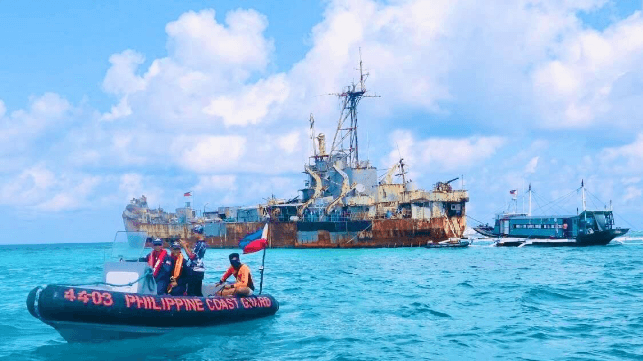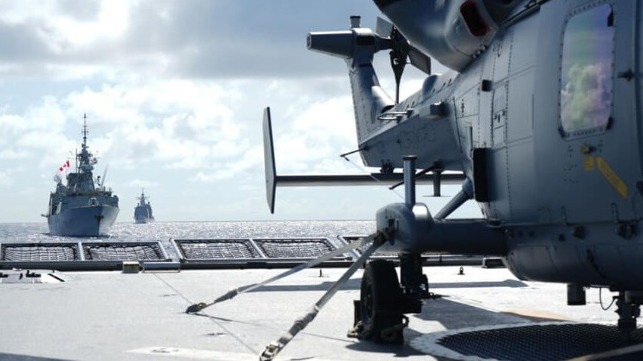Manila Secures New Partnerships for Defense of its Maritime Rights

The aging outpost aboard a tank landing ship at Second Thomas Shoal. The AFP has repaired it to last for many more years, four sources told Bloomberg (file image courtesy Jay Tarriela / PCG)
Published Aug 5, 2024 6:13 PM by The Maritime Executive
Just weeks after reaching a de-escalation agreement with the Chinese government, the Philippines has announced a flurry of defense partnerships, drills and supply operations in the South China Sea, all favoring the defense of Manila's exclusive economic zone.
First, four security sources have confirmed to Bloomberg that the Armed Forces of the Philippines (AFP) has managed to repair its rusting outpost on Second Thomas Shoal, where Chinese forces have been attempting to deny access and push Philippine troops out. The repairs have been so successful that they should be sufficient to keep the outpost going for up to ten years, the sources told Bloomberg.
The news of the successful repair work is positive for the AFP, which has warned that the structure - a grounded WWII tank landing ship that is now eight decades old - was so decayed that it might have to be abandoned within a few years' time. China vigorously opposes the presence of the garrison within the Philippine exclusive economic zone, and has attempted to block resupply missions with force. Last week, after the announcement of a confidential de-escalation agreement with Beijing, AFP forces carried out a resupply mission to the reef without interference from Chinese forces.
Partnership patrols with Vietnam, Japan and U.S.
On August 5, the Vietnam Coast Guard cutter CSB 8002 called in Manila for the start of joint exercises with the Philippine Coast Guard. Though Hanoi and Manila have competing views of their respective maritime boundaries in the South China Sea, they have committed to a peaceful resolution process centered on international law and negotiation - drawing an unspoken contrast with China's unilateral expansion.
Beijing claims sovereignty over almost all of the South China Sea, including international waters and neighboring states' exclusive economic zones. Beijing continues to reject a 2016 international arbitral ruling that affirmed the Philippines' EEZ boundaries, adopting an official policy of "non-acceptance, non-participation, and non-recognition" of the Permanent Court of Arbitration in the Hague and the rules-based implementation of the UN Convention on the Law of the Sea. In pursuit of its own interpretation of regional maritime boundaries, China has authorized the use of force against Philippine servicemembers inside of the Philippine exclusive economic zone. Multiple Philippine nationals have been injured in clashes with the China Coast Guard since the start of 2024, when the CCG adopted tougher rules of engagement; no CCG personnel have been harmed in response.
Vietnam has had similar run-ins with Chinese forces in the past, all centered on oil and gas E&P. China claims a large swathe of the Vietnamese EEZ, and has attempted to lay claim to its subsea resources as well. In 2014-16 a Chinese state oil firm attempted to carry out drilling in disputed waters of the Gulf of Tonkin, backed up by gray-zone forces of the Chinese maritime militia. Chinese vessels have also conducted unauthorized subsea surveys in Vietnamese waters, and have regularly harassed foreign-operated drilling rigs on Vietnamese license blocks, prompting several international partners to pull out.
In addition to the partnership-building drills with Vietnam's coast guard, the Philippine Navy held its first bilateral drills with the Japan Maritime Self Defense Force in the South China Sea last week, the service announced Friday. It also held a rare drill with the U.S. Navy littoral combat ship USS Mobile, near a contested reef within the western Philippine EEZ; most U.S. gray-hull patrols with the Philippine Navy have been conducted in less sensitive locations, outside of the contested area where China's unilateral claims overlap with Philippine waters.
On Sunday, Manila also announced talks on a new defense partnership with Germany, coinciding with the first-ever visit of a German defense minister to Manila. The planned agreement covers training and weapons exports, said German minister Boris Pistorius, and is part of Germany's commitment to "maintaining rules-based order, securing freedom of navigation and protecting trade routes."
Chinese state-owned opinion outlet Global Times objected to Pistorius' remarks. Citing an anonymous expert on Chinese foreign affairs, GT called the German minister's public support for Philippine maritime rights "a blatant provocation against China that exacerbates tensions."
"Support for the Philippines at the cost of damaging ties with China brings no benefits to Berlin," warned GT. "There is great potential and space for rational and pragmatic cooperation between China and Germany, which is mutually beneficial and win-win."
Published Aug 5, 2024 6:13 PM by The Maritime Executive
Just weeks after reaching a de-escalation agreement with the Chinese government, the Philippines has announced a flurry of defense partnerships, drills and supply operations in the South China Sea, all favoring the defense of Manila's exclusive economic zone.
First, four security sources have confirmed to Bloomberg that the Armed Forces of the Philippines (AFP) has managed to repair its rusting outpost on Second Thomas Shoal, where Chinese forces have been attempting to deny access and push Philippine troops out. The repairs have been so successful that they should be sufficient to keep the outpost going for up to ten years, the sources told Bloomberg.
The news of the successful repair work is positive for the AFP, which has warned that the structure - a grounded WWII tank landing ship that is now eight decades old - was so decayed that it might have to be abandoned within a few years' time. China vigorously opposes the presence of the garrison within the Philippine exclusive economic zone, and has attempted to block resupply missions with force. Last week, after the announcement of a confidential de-escalation agreement with Beijing, AFP forces carried out a resupply mission to the reef without interference from Chinese forces.
Partnership patrols with Vietnam, Japan and U.S.
On August 5, the Vietnam Coast Guard cutter CSB 8002 called in Manila for the start of joint exercises with the Philippine Coast Guard. Though Hanoi and Manila have competing views of their respective maritime boundaries in the South China Sea, they have committed to a peaceful resolution process centered on international law and negotiation - drawing an unspoken contrast with China's unilateral expansion.
Beijing claims sovereignty over almost all of the South China Sea, including international waters and neighboring states' exclusive economic zones. Beijing continues to reject a 2016 international arbitral ruling that affirmed the Philippines' EEZ boundaries, adopting an official policy of "non-acceptance, non-participation, and non-recognition" of the Permanent Court of Arbitration in the Hague and the rules-based implementation of the UN Convention on the Law of the Sea. In pursuit of its own interpretation of regional maritime boundaries, China has authorized the use of force against Philippine servicemembers inside of the Philippine exclusive economic zone. Multiple Philippine nationals have been injured in clashes with the China Coast Guard since the start of 2024, when the CCG adopted tougher rules of engagement; no CCG personnel have been harmed in response.
Vietnam has had similar run-ins with Chinese forces in the past, all centered on oil and gas E&P. China claims a large swathe of the Vietnamese EEZ, and has attempted to lay claim to its subsea resources as well. In 2014-16 a Chinese state oil firm attempted to carry out drilling in disputed waters of the Gulf of Tonkin, backed up by gray-zone forces of the Chinese maritime militia. Chinese vessels have also conducted unauthorized subsea surveys in Vietnamese waters, and have regularly harassed foreign-operated drilling rigs on Vietnamese license blocks, prompting several international partners to pull out.
In addition to the partnership-building drills with Vietnam's coast guard, the Philippine Navy held its first bilateral drills with the Japan Maritime Self Defense Force in the South China Sea last week, the service announced Friday. It also held a rare drill with the U.S. Navy littoral combat ship USS Mobile, near a contested reef within the western Philippine EEZ; most U.S. gray-hull patrols with the Philippine Navy have been conducted in less sensitive locations, outside of the contested area where China's unilateral claims overlap with Philippine waters.
On Sunday, Manila also announced talks on a new defense partnership with Germany, coinciding with the first-ever visit of a German defense minister to Manila. The planned agreement covers training and weapons exports, said German minister Boris Pistorius, and is part of Germany's commitment to "maintaining rules-based order, securing freedom of navigation and protecting trade routes."
Chinese state-owned opinion outlet Global Times objected to Pistorius' remarks. Citing an anonymous expert on Chinese foreign affairs, GT called the German minister's public support for Philippine maritime rights "a blatant provocation against China that exacerbates tensions."
"Support for the Philippines at the cost of damaging ties with China brings no benefits to Berlin," warned GT. "There is great potential and space for rational and pragmatic cooperation between China and Germany, which is mutually beneficial and win-win."

No comments:
Post a Comment